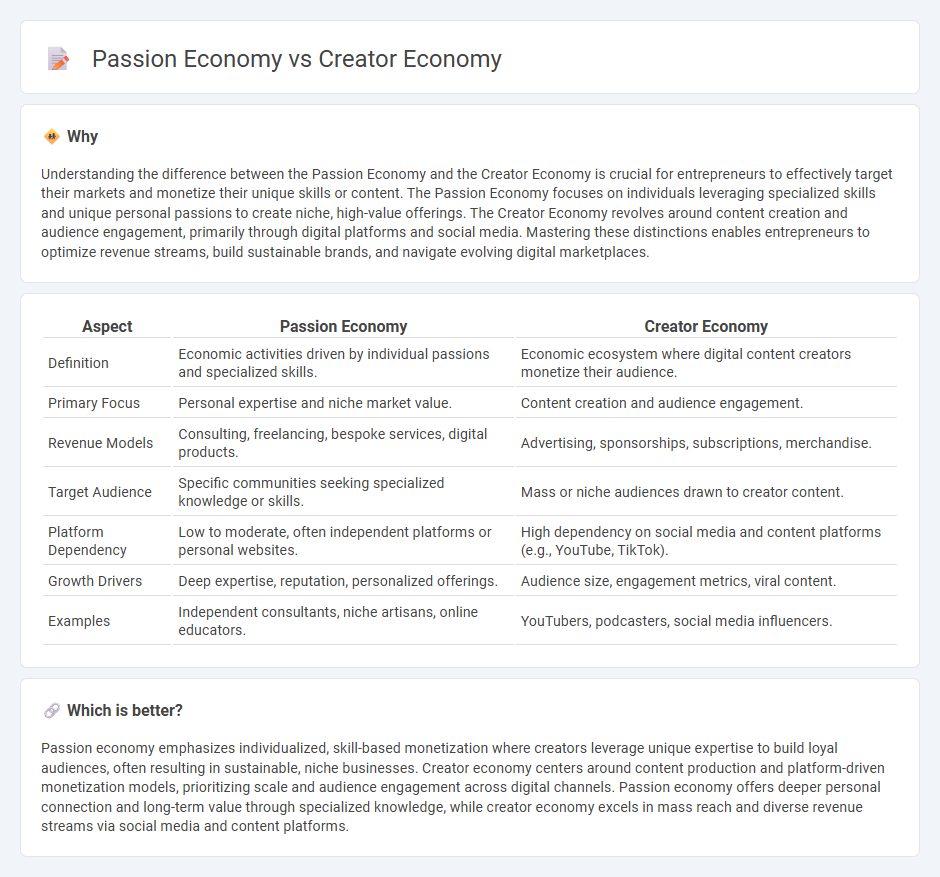
The passion economy emphasizes individuals monetizing unique skills and authentic personal brands, fostering deep customer relationships through specialized services. In contrast, the creator economy focuses on content production and distribution at scale, leveraging platforms like YouTube, TikTok, and Patreon to reach broader audiences. Explore how these evolving economic models shape entrepreneurial opportunities and redefine value creation.
Why it is important
Understanding the difference between the Passion Economy and the Creator Economy is crucial for entrepreneurs to effectively target their markets and monetize their unique skills or content. The Passion Economy focuses on individuals leveraging specialized skills and unique personal passions to create niche, high-value offerings. The Creator Economy revolves around content creation and audience engagement, primarily through digital platforms and social media. Mastering these distinctions enables entrepreneurs to optimize revenue streams, build sustainable brands, and navigate evolving digital marketplaces.
Comparison Table
| Aspect | Passion Economy | Creator Economy |
|---|---|---|
| Definition | Economic activities driven by individual passions and specialized skills. | Economic ecosystem where digital content creators monetize their audience. |
| Primary Focus | Personal expertise and niche market value. | Content creation and audience engagement. |
| Revenue Models | Consulting, freelancing, bespoke services, digital products. | Advertising, sponsorships, subscriptions, merchandise. |
| Target Audience | Specific communities seeking specialized knowledge or skills. | Mass or niche audiences drawn to creator content. |
| Platform Dependency | Low to moderate, often independent platforms or personal websites. | High dependency on social media and content platforms (e.g., YouTube, TikTok). |
| Growth Drivers | Deep expertise, reputation, personalized offerings. | Audience size, engagement metrics, viral content. |
| Examples | Independent consultants, niche artisans, online educators. | YouTubers, podcasters, social media influencers. |
Which is better?
Passion economy emphasizes individualized, skill-based monetization where creators leverage unique expertise to build loyal audiences, often resulting in sustainable, niche businesses. Creator economy centers around content production and platform-driven monetization models, prioritizing scale and audience engagement across digital channels. Passion economy offers deeper personal connection and long-term value through specialized knowledge, while creator economy excels in mass reach and diverse revenue streams via social media and content platforms.
Connection
Passion economy drives the creator economy by enabling individuals to monetize their unique skills and personal interests through digital platforms. This synergy fosters innovative entrepreneurship, where creators build niche markets and personalized brands that generate sustainable income streams. Both economies thrive on direct audience engagement, leveraging technology to transform passion into profitable ventures.
Key Terms
Monetization
The creator economy emphasizes monetization through platform-driven methods like ad revenue, brand deals, and subscriber fees, leveraging scalable audiences across social media networks such as YouTube, TikTok, and Instagram. In contrast, the passion economy centers on personalized, high-value offerings like coaching, niche mentorships, and bespoke content, prioritizing quality over quantity and direct creator-client relationships. Explore deeper insights on how these models reshape income strategies in digital entrepreneurship.
Audience engagement
The creator economy emphasizes broad audience reach through scalable content platforms, leveraging social media algorithms to maximize visibility and monetization. In contrast, the passion economy prioritizes deep, niche audience engagement where creators build loyal communities by offering personalized content, unique experiences, and direct interaction. Explore how audience engagement strategies differ fundamentally between these economies and discover which approach aligns best with your creative goals.
Platform dependency
The creator economy heavily relies on centralized platforms such as YouTube, TikTok, and Instagram, which control algorithms, monetization terms, and audience access, raising concerns about platform dependency and revenue stability. In contrast, the passion economy emphasizes individual ownership of audience and content, enabling creators to monetize skills and niche interests through direct subscriptions, personalized services, and independent platforms, reducing reliance on any single platform. Explore how shifting from platform dependency to autonomy transforms creative entrepreneurship and financial resilience.
Source and External Links
A guide to the creator economy in 2025 (+ benefits for brands) - Impact - The creator economy is a growing industry where individuals produce and share content online to monetize their skills and audience through brand partnerships, ad revenue, subscriptions, merchandise, and crowdfunding, currently valued at $250 billion and expected to almost double by 2027.
The creator economy could approach half-a-trillion dollars by 2027 - The creator economy, fueled by digital media consumption and new content platforms, is projected to grow to $480 billion by 2027, driven primarily by influencer marketing, platform advertising payouts, and brand collaborations with 50 million global creators expanding at 10-20% annually.
What is the creator economy? Influencer tools and trends - SignalFire - The creator economy encompasses over 50 million independent content creators and community builders who leverage software and financial tools to grow and monetize their content, with key trends including creators developing personal platforms, becoming entrepreneurs, and increasing their influence in media ecosystems.
 dowidth.com
dowidth.com